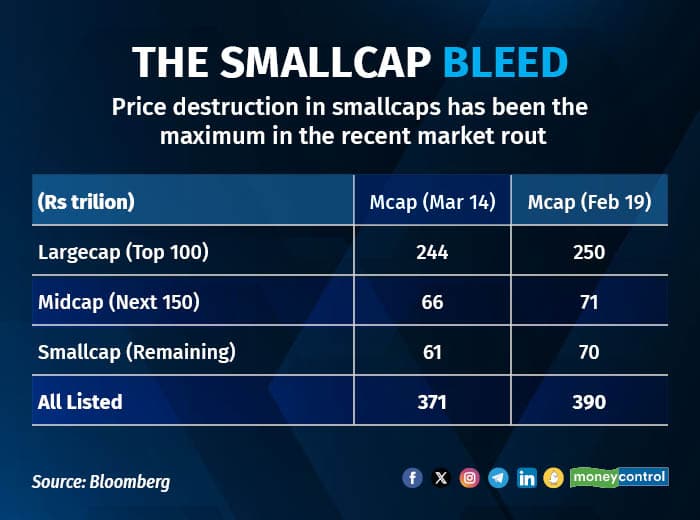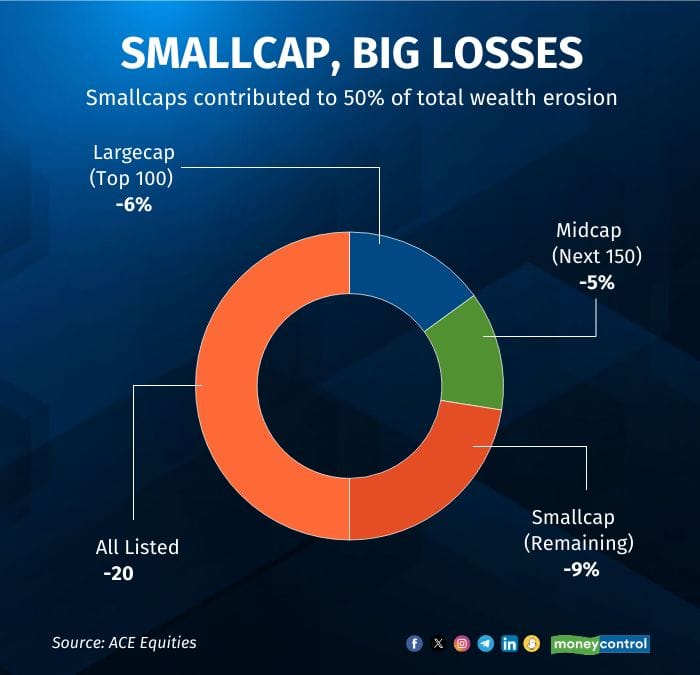How bad is bad? Smallcap carnage wipes out Rs 9 trillion, 50% of total marketcap loss


In an interview on March 13, Harsha Upadhyaya, CIO- Equity at Kotak AMC said, that despite the correction seen in the midcap and smallcap space, Kotak Mahindra AMC has not deployed all the cash at their disposal.
The stock market has seen a significant drop in value since February 19, with smallcap stocks being hit the hardest. Over Rs 9 trillion in investor wealth has been lost due to this market correction, accounting for more than 50% of the total value destruction. However, smallcaps recovered on March 14, with the BSE Smallcap index gaining over 3% after losing 12% since February 19, when the index peaked.
Also read: SEBI mutual fund stress test: Quant MF says smallcap fund to take 22 days for 50% liquidation
Smallcap stocks had a remarkable run over the past year, outpacing largecaps by a wide margin. From April 1, 2023, to February 19, 2024, the BSE Sensex posted a gain of about 24%, compared to BSE Smallcap’s 71%. However, smallcaps have been correcting for the past three weeks due to a combination of factors, including ED raids on a big market operator and allied entities, Sebi flagging ‘froth’ in the market and asking mutual fund trustees to be watchful of flows into small and midcap segments, as well as commissioning a liquidity stress test that has spread fears of unwinding by mutual funds to ‘look good’ on this count. Market participants have also become fearful that the RBI may attempt to thwart money flowing into the stock market.
Biggest smallcap losers

Between February 19 and March 14 this year, as many as 16 stocks from the BSE Smallcap index lost 40-56 percent of their gains from their 52-week highs. Among these, the biggest loss was clocked by Ramky Infrastructure which lost 56 percent after gaining 65 percent in the last one year. Andrew Yule & Company and IFCI saw around 47 percent erosion from their recent 52-week highs. The stocks had risen 72 percent and 252 percent in the preceding rally from April 1, 2023 to February 19, 2024.
About 83 stocks posted 30-40 percent losses from the 52-week highs, while 161 stocks posted 20-30 percent losses. HLV Ltd, Orient Green Power, Balu Forge Industries, Paisalo Digital, Sandur Manganese & Iron Ores, Salasar Techno Engineering, Sangam India, Sigachi Industries, Prakash Industries, Visaka Industries, India Pesticides, Indo Amines and Speciality Restaurants were in the first category.
But, is this correction that bad, or is there more to come?
Story continues below Advertisement

Despite this huge fall, analysts say the recent market correction is relatively minor considering the significant gains of the past year. Despite declines of 10 percent in the BSE Smallcap Index over the past month, they are still up 54 percent over the past year. Notably, 63% of small-cap stocks have provided returns exceeding 30% in the past year, despite most experiencing negative returns in the past month.
In an interview on March 13, Harsha Upadhyaya, CIO- Equity at Kotak AMC said, that despite the correction seen in the midcap and smallcap space, Kotak Mahindra AMC has not deployed all the cash at their disposal. “We are still not deploying all the money that we have at our disposal. Some of the stocks that we like on a fundamental basis are yet to fall to the levels where we would be comfortable to buy those,” said Upadhyaya. “At this point, pockets with excesses building up are witnessing the most correction.”
Also read: MF stress test: India’s biggest small-cap fund can sell off its 50% portfolio in 27 days
In its recent note, Kotak Institutional Equities expressed uncertainty regarding any changes in non-institutional investors’ behaviour despite recent corrections and regulatory warnings. They believe that high return expectations and past gains may have reinforced direct and indirect participation in mid-and small-cap stocks. Domestic institutional investors’ mid- and small-cap funds have become conduits for active non-institutional investors, potentially prioritising momentum and narratives over fundamentals.
Disclaimer: The views and investment tips expressed by investment experts on Moneycontrol.com are their own and not those of the website or its management. Moneycontrol.com advises users to check with certified experts before taking any investment decisions.